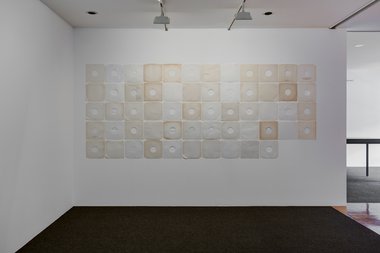John Hurrell – 29 December, 2012
Through researching the past in order to scrutinise certain key events, values or community processes recalled because of various triggering objects, marks or symbols, such memory-loaded ‘traces' take on a power that gallery visitors can think about at length, their loaded contextual details sometimes openly stated, sometimes not.
Auckland
Ruth Ewan
The New Idealism / Paul Robeson project archive/ Them that plants them is soon forgotten
17 November 2012 - 10 February 2013
Through researching the past in order to scrutinise certain key events, values or community processes recalled because of various triggering objects, marks or symbols - they’re the focus of Between Memory and Trace, this (musical) triplet of exhibitions organised by Bruce E. Phillips, Te Tuhi’s curator - such memory-loaded ‘traces’ take on a power that gallery visitors (and the wider community) can think about at length, their loaded contextual details sometimes openly stated, sometimes not.
For example, in this first work Scottish artist Ruth Ewan examines the persecution the great African-American singer Paul Robeson suffered at the hands of the FBI, the American government and black listing mainstream media in the forties, fifties and sixties, his career ruined because of hostility to his outspoken anti-racist and pro-communist views. At one time Robeson was an international superstar. I remember my father playing his records at home in Christchurch in the early sixties when I was eleven, and later hearing how Robeson’s commercial reputation was effectively destroyed by J. Edgar Hoover and others.
The first section (The New Idealism - the title of a speech Robeson made in 1918) of Ewan’s show is a display in the gallery entrance of 58 inner paper LP sleeves on one wall. They all come from Robeson 33 1/3 rpm albums and reveal the circular traces of each shellac pressing, each cover showing an outline of the disk it once contained. Their emptiness becomes a symbol of the shell of a man the stressed and broken Robeson would later become.
The second section (Paul Robeson project archive) is more overtly sinister. It uses a flat vitrine to present paper documents such as historic magazine articles, sheet music, opera programmes, photos of Robeson with communist leaders, record advertisements, his face on 2004 postage stamps, and a copy of his autobiography, and copies of once secret FBI surveillance reports. This is the most chilling, most vivid part of the exhibition.
Of the three, the third section of Ewan’s project (Them that plants them is soon forgotten) is the most poetic, the title being a line from his most famous song, Ol’ Man River, from Showboat. It features two hundred Paul Robeson heritage tomato plants, a Siberian variety of ‘black’ beefsteak tomato with a sweet smoky flavour and coloured a dark red like a tamarillo.
The staked plants have been grown from seedlings and now are being hydroponically irrigated in the Te Tuhi courtyard. The 4 inch wide fruit (that is the technical term for the ripened ovaries of plants) will be collected as they ripen over summer, and then gifted to the visiting public, becoming a succulent symbol for the victims of the McCarthy era, to be remembered while being consumed - a sort of secular Eucharist, a resurrected piece of once-forgotten musical and social history.
John Hurrell










 Two Rooms presents a program of residencies and projects
Two Rooms presents a program of residencies and projects Advertising in this column
Advertising in this column



This Discussion has 0 comments.
Comment
Participate
Register to Participate.
Sign in
Sign in to an existing account.